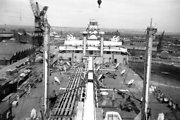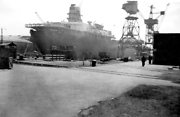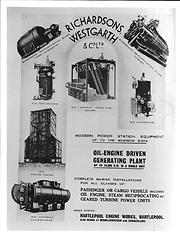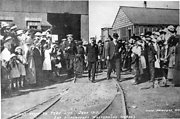 Hartlepool Sports & Leisure
Hartlepool Sports & Leisure
- Cinemas, Theatres & Dance Halls
- Musicians & Bands
- At the Seaside
- Parks & Gardens
- Caravans & Camping
- Sport
 Hartlepool Transport
Hartlepool Transport
- Airfields & Aircraft
- Railways
- Buses & Commercial Vehicles
- Cars & Motorbikes
- The Ferry
- Horse drawn vehicles
 A Potted History Of Hartlepool
A Potted History Of Hartlepool
- Unidentified images
- Sources of information
- Archaeology & Ancient History
- Local Government
- Printed Notices & Papers
- Aerial Photographs
- Events, Visitors & VIPs
 Hartlepool Trade & Industry
Hartlepool Trade & Industry
- Trade Fairs
- Local businesses
- Iron & Steel
- Shops & Shopping
- Fishing industry
- Farming & Rural Landscape
- Pubs, Clubs & Hotels
 Hartlepool Health & Education
Hartlepool Health & Education
- Schools & Colleges
- Hospitals & Workhouses
- Public Health & Utilities
- Ambulance Service
- Police Services
- Fire Services
 Hartlepool People
Hartlepool People
 Hartlepool Places
Hartlepool Places
 Hartlepool at War
Hartlepool at War
 Hartlepool Ships & Shipping
Hartlepool Ships & Shipping

Richardsons Westgarth Engineering
Details about Richardsons Westgarth Engineering
"Richies" was the local name for Richardsons Westgarth Engineering Co. Ltd., Hartlepool.
Location
Related items () :
 1940 - Grays v Richardson Westgarth Rugby Team
1940 - Grays v Richardson Westgarth Rugby Team
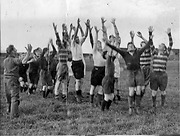 Donated by John Dee
Donated by John DeeGray's Richardson rugby team training circa 1940. Two of the local ship yards used to join ranks and form a rugby team. Here they can be seen being put through their paces by Johnny Dee.
Games between Richies and Grays were a feature of the town programme until the 1960s.
More detail » 1954 Drawing Office staff - Colin Oglesby
1954 Drawing Office staff - Colin Oglesby
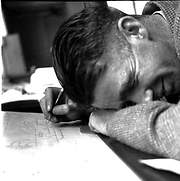 Donated by Mr. John Robinson
Donated by Mr. John RobinsonDated 1954
Richardsons Westgarth draughtsman Colin Oglesby in 1954 - made a mistake perhaps?
More detail » 1954 Drawing Office staff - Dave Judkins
1954 Drawing Office staff - Dave Judkins
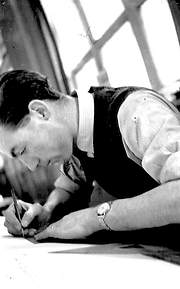 Donated by Mr. John Robinson
Donated by Mr. John RobinsonDated 1954
Richardsons Westgarth draughtsman Dave Judkins in 1954.
More detail » 1954 Drawing Office staff - Jack Watson
1954 Drawing Office staff - Jack Watson
 Donated by Mr. John Robinson
Donated by Mr. John RobinsonDated 1954
Richardsons Westgarth drawing office Section Leader Jack Watson in 1954.
More detail » 1954 Drawing Office staff - John Robinson
1954 Drawing Office staff - John Robinson
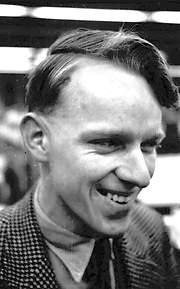 Donated by Mr. John Robinson
Donated by Mr. John RobinsonDated 1954
John Robinson worked at Richardson Westgarth from 1949 to 1963. Due to the uncertainties of work, John then left to work for English Electric in Rugby. After four years in Rugby, he emigrated to Canada and worked for the next 30 years as a consulting engineer until retirement in 1997.
More detail » A Post-war Apprenticeship
A Post-war Apprenticeship
World War 2 had come to an end and the country was slowly getting back normality. At that time my father was working at the South Durham Steel Works as a dilutee electrician. “Dilutees” were tradesmen's helpers who were up-graded to, machinists, fitters, electrician's etc. to help to make up for the loss of the countries skilled workers because of the thousands that were 'called-up' into the armed forces. As far as I can remember, if they served in these positions for a period of 5 or 6 years, they would be given skilled workers status.
I remember my father telling me that he would like to see me serving an apprenticeship. That is what I did, and Richardsons Westgarth was the company I applied to.
Going for my first job interview was quite scary. The personnel officer greeted me and took me to his office and asked me a lot of questions, and then pointed to a mortise lock in bits and pieces on his desk and asked me to assemble it.
Now, when I think of that mortise lock and then look at all the engineering work I have done since then, I can't think why I was afraid of that humble little mortise lock. I was delighted when I received word back that my application was successful.
On my first day at work I was told I would be working on Reception for a couple of weeks, alongside another apprentice called Billy Bishop; his father worked in the tool room in the turbine part of the factory. Billy became a good friend throughout my apprenticeship. Mr. Harding was in charge of Reception and every morning he would stand by the main entrance doors ready to pull them open and stand there when the director (Mr. Loverage) arrived. We used to take turns standing at the hatch window, which was quite boring.
However, it was just for two or three weeks and then we were "released" into the factory. The Machine Shop was to be my first place of learning, at the marking off table, and it was here where I had my first accident. I was rolling a big flange along the floor and it toppled over and broke my big toe. I was helped to the ambulance room and then transported to the hospital for x-ray. I was provided with a pair of crutches and sent home.
After recovery, I was told that my training would continue in the Erecting Shop, where the big four cylinder Doxford diesel engines were built. I was working on the entablature, the part of the engine supporting the cam shafts and fuel injectors. The charge hand was Mr. Hoffman; he was good to work for and I learned a lot from him. On another part of the erecting shop I worked for a while on turbo chargers, Mr. Fleetham was in charge here and he was another man I had a lot of respect for.
During this time Richardsons had contract work at some of the power stations throughout the country. Battersea Power Station was one of them and "B" station was still having machinery installed. Apprentices could have part of their training there if they so wished. I applied along with another apprentice, Stan Newson. For the next 14 months, this would be a new venture for us. The company arranged lodgings for us, and I soon found that working away from home wasn't easy. The lodging was quite poor to the point where the landlady’s-ex came in one day with some very threatening language. We decided that it was time move, and we found better lodgings in Hammersmith.
Working in London was quite exciting for a couple of young lads. Stan and I were keen cyclists at that time. We had our bicycles sent down and ventured into the countryside around London and visited all the inner London places of interest too. I had two aunties living in London and quite naturally they did not like the idea of me being in lodgings and one of them said I could stay with her. Stan was happy staying in Hammersmith.
My aunty lived in Deptford and I was transferred to Deptford Power Station. I enjoyed the work in the power stations, the noise of the turbines, and the complex control rooms was all very fascinating. At the end of my training in the power stations I returned to Richardsons a little wiser with some more knowledge. I was working with Mr. Fleetham again on the turbo chargers right up to the end of my apprenticeship in 1950. I was encouraged to serve some time as an engineer officer in the Merchant Navy. This I did, and so started another period of time of my engineering career.
Looking back, I can honestly say that I could not have wished for a better apprenticeship, all that I learnt has served me well throughout my career in engineering. Since then I have worked as a production engineer, training officer, and development engineer. Would I do it all again? you bet I would!.
More detail » A Richardsons Westgarth Apprenticeship - John Robinson
A Richardsons Westgarth Apprenticeship - John Robinson
The company always encouraged their apprentices to better themselves by attending the Technical College. Since this meant going to evening classes at least 3 times a week after work from 6 until 9 (:30)pm, not many apprentices did this. For most people, the program took five years, three at the senior level and two at the advanced level. If the person’s education was not high enough for the senior level, it was possible to start at a two year junior level.
The company offered a small financial reward for passing each level (as did the unions, if you were a member). Usually after passing the senior level they would offer training in the drawing office. There were other incentives on reaching the advanced level, the first year earned a half day off work with pay for study, the second year a full day off. Needless to say, not having to go as much in the evenings was appreciated. By this stage there were only a handful of apprentices in the program and those that finished usually went on for further study at university or joined the Merchant Navy as Engineering Officers.
More detail » Alan Grange 1
Alan Grange 1
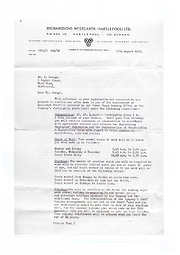 Donated by Alan Grange
Donated by Alan GrangeLetter received by Allan Grange from Richardsons Westgarth informing him he had been successful with his applictaion for the post of Assistant Statfile Operator in our Power Plant Drawing Office.
More detail » Alan Grange 2
Alan Grange 2
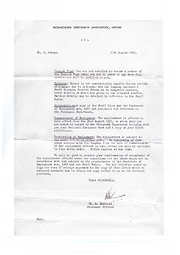 Donated by Alan Grange
Donated by Alan GrangeLetter received by Allan Grange from Richardsons Westgarth informing him he had been successful with his applictaion for the post of Assistant Statfile Operator in our Power Plant Drawing Office.
More detail » Alan Grange 3
Alan Grange 3
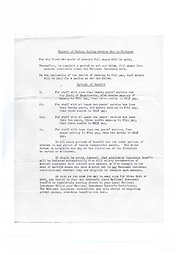 Donated by Alan Grange
Donated by Alan GrangeLetter received by Allan Grange from Richardsons Westgarth informing him he had been successful with his applictaion for the post of Assistant Statfile Operator in our Power Plant Drawing Office.
More detail » All Aboard for Battersea
All Aboard for Battersea
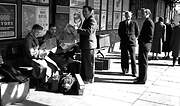 Donated by Mr. John Robinson
Donated by Mr. John RobinsonDated 1954
In 1954 a group from Richies Drawing Office were sent to do a performance test at Battersea Power Station in London. The group are (l to r): Cliff Fleetham, Arthur ?, ?, Dick Hunter and Jack Watson. Dick Hunter was the engineer in charge of the condenser and feedheater design.
More detail » Alternator Test Pit
Alternator Test Pit
 Dated 1963
Dated 1963Eric Mudd, of Oron, Ontario, Canada, with work colleagues in the Alternator Test Pit at Richies in 1963. To Eric's left is his journeyman and Shop Steward Ron Mitchell. to my left is Ron Mitchell... "Great days".
More detail » An evening out
An evening out
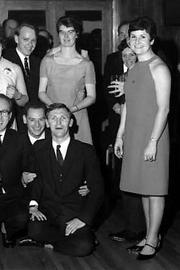 Created by unknown
Donated by Mr. John Robinson
Created by unknown
Donated by Mr. John RobinsonFormer Richrdson Westgarth apprentice Fred Gook (centre, kneeling), and his wife Pat (nee Ward) both from Hartlepool. Pat was secretary to one of the RW directors, Bernard Wyatt. Fred worked as an engineer in the condenser and feedwater heating department. Standing behind Fred are myself (John Robinson) and my wife Ann.
More detail »
 Baptism - 1962
Baptism - 1962
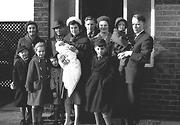 Created by Billy Robinson
Donated by John Robinson
Created by Billy Robinson
Donated by John RobinsonDated 1962
A group photograph of the Robinson family about to set off for the baptism of John and Anne's son Paul, at Holy Trinity Seaton Carew in 1962. Holding baby Paul is Mary Robinson, wife of John's brother Harry and formerly a secretary at "Richies". The photographer was Billy Robinson.
More detail » Checking things out
Checking things out
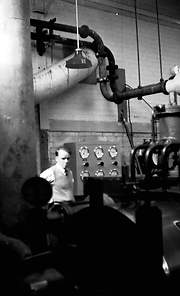 Donated by Mr. John Robinson
Donated by Mr. John RobinsonJohn Robinson keeping an eye on things in 1962.
More detail » Chief Fire Officer
Chief Fire Officer
 Donated by Mrs. Silvia Jolly (nee Sanderson)
Donated by Mrs. Silvia Jolly (nee Sanderson)Dated 1928
Mr Richard Hayton Sanderson, in full dress uniform as Chief Fire Officer at Richardson Westgarth, 1928.
More detail » Cyclists
Cyclists
 Donated by Mr. John Robinson
Donated by Mr. John RobinsonThe cyclists in the picture are left to right: Jim Robinson, Cliff Sorensen, Harry Robinson and Tommy Kell. Cliff, Harry and Tommy were at that time (mid to late 1940’s) apprentices at Richardson Westgarth. At this time, Tommy and Harry were members of a Hartlepool cycling club and Jim occasionally would join them in their rides. They often cycled to Billingham to swim at the baths. What they had not realised on the first visit was that Harry could not swim; he saw them in the pool treading water and thought they were standing and jumped in and Jim had to rescue him.
More detail » Dave and Audrey Judkins
Dave and Audrey Judkins
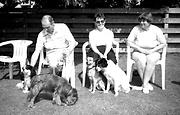 Created by Jim Robinson
Donated by John Robinson
Created by Jim Robinson
Donated by John RobinsonDated 1990
Dave was born in Hartlepool in 1924, and married Audrey Pugh in 1950. He attended school with my uncle Tommy Kell and served his apprenticeship at Richardson Westgarth. He was a lifelong friend of my uncle, and my brother's Harry and Jim Robinson. I also worked with him for five years in the drawing office. The photograph was taken in 1990, with Dave, his wife Audrey (center) and Doris Robinson (Jim's wife).
More detail » Electric Supply Control Panel
Electric Supply Control Panel
 Created by Mr. John Brooker
Donated by Mr. John Brooker
Created by Mr. John Brooker
Donated by Mr. John BrookerRichardson Westgarth’s (Ferry Road, Middleton, Hartlepool), Electric Supply Control Panel. Note the ‘Railway Points’ main switch. Underneath this Control Panel was a ‘secret’ nightshift room incorporating five made-up single beds which were still in situ in 1985, obviously for the ‘nightshift’ to get their heads down during the night!
More detail » Fire Officer Sanderson
Fire Officer Sanderson
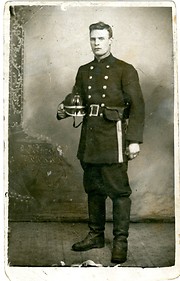 Donated by Mrs. Silvia Jolly (nee Sanderson)
Donated by Mrs. Silvia Jolly (nee Sanderson)Richard Sanderson, Chief Fire Officer at "Richies", strikes a pose in his fire service uniform.
More detail » Gas Turbine 1
Gas Turbine 1
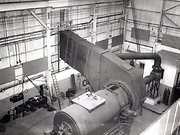 Created by Unknown
Donated by Stuart James Wilson
Created by Unknown
Donated by Stuart James WilsonDated 1966
This photograph shows one of four gas turbines (C. 5926-7-8-9) built by "Richies" for Fawley Power Station.
More detail » Gas Turbine 2
Gas Turbine 2
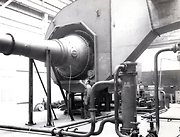 Created by Unknown
Donated by Stuart James Wilson
Created by Unknown
Donated by Stuart James WilsonDated 1966
Jim Wilson pictured with ducting for one of the four gas turbines (C. 5926-7-8-9) built by "Richies" for Fawley Power Station.
More detail » Gulf Tanker Turbines
Gulf Tanker Turbines
Recollections of the Gulf Tanker Turbines – John Robinson
I noted with interest the pictures submitter by Jim Wilson re the Gulf Tankers and their steam turbine drives. From memory there were four ships ordered at this time, more or less identical. There is a little bit of history behind the design of these marine turbines. Normally they would have been supplied by Parsons in Newcastle upon Tyne but there was such a high demand at that time that deliveries could not be met, to meet the completion date for the ship.
The turbine works of Richardson Westgarth (Richies), were licensed to manufacture turbines designed by Brown Boveri in Switzerland. Richies had no control over the design or drawings, only their translation into English. The manager of the turbine works a Mr. Signer, a Swiss engineer with high skills in manufacturing and quality control but showed little respect for English engineers or the skilled factory workers. To assist in the interpretation of the designs, there were two Swiss engineers (Salm and Steiner) on loan from Brown Boveri and Signer’s own son, an English engineering graduate trained in Switzerland. On the manufacturing side a brilliant young Hartlepool engineer, Bill Atkinson looked after the workshops as assistant manager to Signer.
Brown Boveri were approached to provide turbine designs for these new tankers. The engines were outside the range of their standard machines and they could not free up man power to do a completely new design. It was decided that they would do the design in Hartlepool and have Brown Boveri review it before manufacturing.
My brother Harry, a graduate from Durham University, Kings College in Mechanical Engineering and Naval Architecture, and a Richies apprentice, was working in the turbine drawing office gaining design experience under Max Salm, the Swiss Engineer. Harry was given the job for the design of these machines which were eventually manufactured and installed in the Gulf tankers.
There was another aspect of these machines that is interesting; the turbines ran at a few thousand rpm and the speed had to be reduced to about 100 rpm for the propeller. You can see the double helix gear in one of the pictures. Richies bought a machine to cut these gears and Bill Atkinson trained a semi-skilled machine operator (Ernie Walker) from the blade shop for this task. There is no margin for errors when cutting these gears and the fact that they were cut in an open machine shop without climate control or computers shows a high level of skill from this team.
I also had a connection with these tankers, as I worked in the marine drawing office producing drawings of equipment foundations and piping systems.
More detail »
 Gulf Tankers
Gulf Tankers
Four identical ships, Gulf Briton, Gulf Dane, Gulf Scot and Gulf Finn, were built for Britannia Tankers Ltd., a British flag affiliate of Gulf Oil, at the Furness Shipyard, Haverton Hill, Middlesbrough. Richardsons Westgarth (Richies), at Hartlepool supplied the gearing and thrust block for one of these ships. Ships of the Gulf Briton class were notable for being the last marine steam-turbine installations from Richies.
More detail » High on the scaffold
High on the scaffold
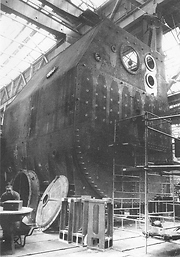 Donated by Mr. Brian Tunstall
Donated by Mr. Brian TunstallDated 1963
Richardson, Westgarth Apprentice Brian Tunstall high up on the scaffold working on power station equipment in 1963.
More detail » Hitch-hiking Apprentices
Hitch-hiking Apprentices
 Created by Marianna Gluge
Donated by John Robinson
Created by Marianna Gluge
Donated by John RobinsonDated 1953
"Richies" Apprentices Clifford (Cliff) Smith (left), and John Robinson hitch-hiking on the Isle of Skye in 1953. The photograph was taken by Marianna Gluge, a French student from Nice.
More detail » In the Canteen
In the Canteen
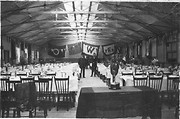 Donated by Mr. Cliff Thornton
Donated by Mr. Cliff ThorntonDated 1919
In 1919 Richardson Westgarth wanted to develop a canteen for their office staff, and in May of that year, Arthur E Thornton (on the right), was appointed to develop and manage the canteen. Arthur managed the canteen for two years before leaving to go and manage Birk's Commercial Hotel in Church Street. This photograph probably shows the canteen set up for a Peace Day celebration (19th July 1919). The flags in the silver cup are those of the Allies in the First World War and the tablecloths and silverware on show were probably not in everyday use!
More detail »
 Jim Wilson at Richardsons Westgarth
Jim Wilson at Richardsons Westgarth
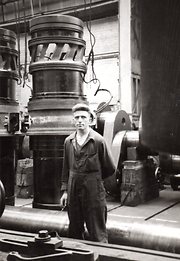 Created by Unknown
Donated by Stuart James Wilson
Created by Unknown
Donated by Stuart James WilsonDated 1955
Background shows cylinder liners and crankshaft from North-Eastern Marine Doxford oil engine, a type built by RW circa 1945-57.
More detail » Jim Wilson at Richies
Jim Wilson at Richies
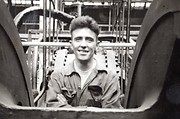 Created by Unknown
Donated by Stuart James Wilson
Created by Unknown
Donated by Stuart James WilsonDated 1955
Jim is shown looking over the top of a marine steam-turbine gearcase.
More detail » Jim Wilson: Workbook Extract 1
Jim Wilson: Workbook Extract 1
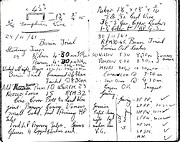 Created by Jim Wilson
Donated by Stuart James Wilson
Created by Jim Wilson
Donated by Stuart James WilsonDated 1961
An extract from one of Jim Wilson's personal workbooks concerning a basin trial for a Gulf tanker built by the Furness Shipbuilding Co. of Haverton Hill and engined by RW. Erection and installation of the main machinery was supervised by Jim Wilson.
More detail » Jim Wilson: Workbook Extract 2
Jim Wilson: Workbook Extract 2
 Created by Jim Wilson
Donated by Stuart James Wilson
Created by Jim Wilson
Donated by Stuart James WilsonDated 1963
An extract from Jim Wilson's personal workbook concerning sea trials for a Gulf tanker, built by Furness Shipbuilding of Haverton Hill and engined by RW. Jim was responsible for the erection and installation of main machinery, also supervising machinery performance during sea trials.
More detail » John Robinson - Apprentice Fitter Certificate
John Robinson - Apprentice Fitter Certificate
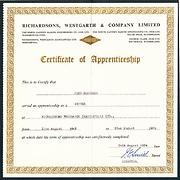 Created by Richardsons Westgarth
Donated by Mr. John Robinson
Created by Richardsons Westgarth
Donated by Mr. John RobinsonDated 1954
John Robinson's Certificate of Apprenticeship awarded after serving five years as a Fitter.
More detail » John Smith in the Tool Shop
John Smith in the Tool Shop
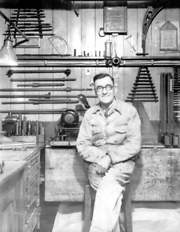 Donated by Mr. John Robinson
Donated by Mr. John RobinsonTool maker John Smith in the very well-ordered Tool Shop at Richardsons Westgarth in the 1950s.
More detail » Lobbying for work
Lobbying for work
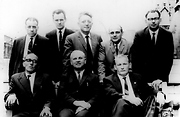 Donated by Rita Parrish
Donated by Rita ParrishTed Leadbitter (front centre), and others, on a visit to London to lobby MPs to try and secure work for Richardsons Westgarth.
More detail » Motor Trawler St. Hilda (1)
Motor Trawler St. Hilda (1)
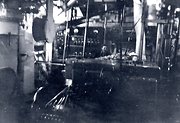 Created by Unknown
Donated by Stuart James Wilson
Created by Unknown
Donated by Stuart James WilsonDated 1959
Photograph showing engine room prior to overhaul by Richardsons, Westgarth personnel under the supervision of Jim Wilson.
More detail » Motor Trawler St. Hilda (2)
Motor Trawler St. Hilda (2)
 Created by Jim Wilson
Donated by Stuart James Wilson
Created by Jim Wilson
Donated by Stuart James WilsonDated 1959
Machinery layout sketched by Jim Wilson prior to overhaul by "Richies" personnel.
More detail » Motor Trawler St. Hilda (3)
Motor Trawler St. Hilda (3)
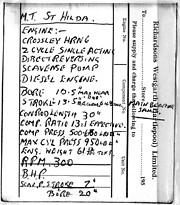 Created by Jim Wilson
Donated by Stuart James Wilson
Created by Jim Wilson
Donated by Stuart James WilsonDated 1959
Machinery details written up by Jim Wilson during engine overhaul by personnel from RW.
More detail » Motor Trawler St. Hilda at the Fish Quay
Motor Trawler St. Hilda at the Fish Quay
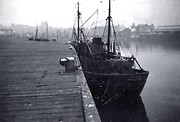 Created by Unknown
Donated by Stuart James Wilson
Created by Unknown
Donated by Stuart James WilsonDated 1959
As well as their core business of marine steam-turbines and land-based turbo-alternators, RW also overhauled the machinery of local vessels. Jim Wilson supervised repairs to this boat. The St. Hilda was built by H. Scurr of Hessle in 1959 for the Friarage S.F. Co. of Hartlepool.
More detail » NCME - John Robinson
NCME - John Robinson
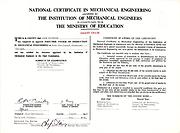 Created by NCME
Donated by Mr. John Robinson
Created by NCME
Donated by Mr. John RobinsonDated 1954
The National Certificate in Mechanical Engineering awarded to John Robinson in 1954.
More detail » NCTEC - John Robinson
NCTEC - John Robinson
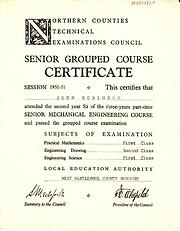 Created by NCTEC
Donated by Mr. John Robinson
Created by NCTEC
Donated by Mr. John RobinsonThe Northern Counties Technical Examinations Council Certificate awarded to John Robinson in 1951.
More detail » Out in the Field (1)
Out in the Field (1)
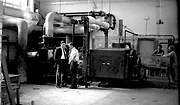 Donated by Mr. John Robinson
Donated by Mr. John Robinson In 1962 Richies supplied a small turbo-generator to I.C.I. Dyestuffs Division in Manchester. On the left is Bill Pickens (After Sales Service), and Bill Boyes (Field Erector).
More detail » Richardson & Westgarth's Sheerleg Crane
Richardson & Westgarth's Sheerleg Crane
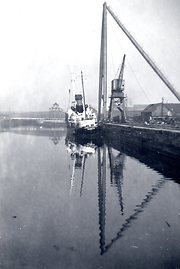 Created by Unknown
Donated by Stuart James Wilson
Created by Unknown
Donated by Stuart James WilsonDated 1955
These sheerlegs were used for lifting main machinery built by RW into ships.
More detail » Richardson & Westgarth's Sheerleg Crane (2)
Richardson & Westgarth's Sheerleg Crane (2)
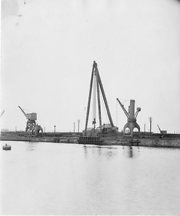 Donated by Hartlepool Museum Service
Donated by Hartlepool Museum ServicePart of the Shipbuilding collection
Richardson & Westgarth's 80 ton Sheerleg Crane.
More detail » Richardson & Westgarth's Sheerleg Crane (3)
Richardson & Westgarth's Sheerleg Crane (3)
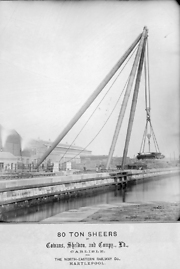 Donated by Hartlepool Museum Service
Donated by Hartlepool Museum ServicePart of the Shipbuilding collection
Richardson & Westgarth's 80 ton Sheerleg Crane.
More detail » Richardson Westgarth from Middleton beach
Richardson Westgarth from Middleton beach
 Created by Bill Henderson
Donated by Bill Henderson
Created by Bill Henderson
Donated by Bill HendersonDated 1983
Taken from Middleton beach about 1983.
More detail » Richardson Westgarth typists 1948
Richardson Westgarth typists 1948
 Donated by Albert Harris
Donated by Albert HarrisDated 1948
Taken in 1948 on a trip to the Lake District are L-R: Gladys Harland (Harris) Mary Smith, Edna Shears and Joyce Richardson.
Gladys met her future husband Albert Harris on this trip.
More detail » Richardsons Westgarth Office Party - 1962
Richardsons Westgarth Office Party - 1962
 Donated by Mr. John Robinson
Donated by Mr. John RobinsonDated 1962
'Richies' 1962 Office Party. Mr. & Mrs. John Robinson are on the far left of the photograph.
More detail » Richardsons Westgarth Offices - Ferry Street
Richardsons Westgarth Offices - Ferry Street
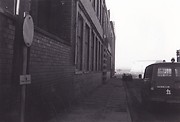 Created by Mr. John Brooker
Donated by Mr. John Brooker
Created by Mr. John Brooker
Donated by Mr. John BrookerRichardsons Westgarth Offices on Ferry Road, Middleton. The Ford Transit van registration dates the photograph to some time after August 1984.
More detail » Richardsons, Westgarth & Co
Richardsons, Westgarth & Co
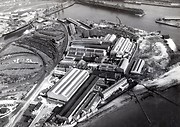 Created by Unknown
Donated by Stuart James Wilson
Created by Unknown
Donated by Stuart James WilsonDated 1957
An aerial view of the Hartlepool Works showing the newly built turbine shop.
More detail » Richardsons, Westgarth Fitting Shop 1
Richardsons, Westgarth Fitting Shop 1
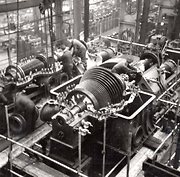 Created by Unknown
Donated by Stuart James Wilson
Created by Unknown
Donated by Stuart James WilsonDated 1957
A steam-turbine set under construction. Jim Wilson is pictured standing third from left in boiler suit and white roll-neck sweater.
More detail » Richardsons, Westgarth Fitting Shop 2
Richardsons, Westgarth Fitting Shop 2
 Created by Unknown
Donated by Stuart James Wilson
Created by Unknown
Donated by Stuart James WilsonDated 1957
A steam-turbine set under construction.
More detail » Richardsons, Westgarth Fitting Shop 3
Richardsons, Westgarth Fitting Shop 3
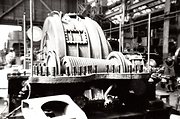 Created by Unknown
Donated by Stuart James Wilson
Created by Unknown
Donated by Stuart James WilsonDated 1957
Steam-turbine set with upper casing of high-pressure turbine not yet fitted. Note the blading and also the studs for bolting together of the turbine casings, assisted by the use of four guide pillars, one at each corner.
More detail » Richardsons, Westgarth Fitting Shop 5
Richardsons, Westgarth Fitting Shop 5
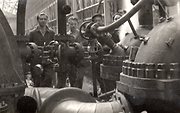 Created by Unknown
Donated by Stuart James Wilson
Created by Unknown
Donated by Stuart James WilsonDated 1955
Steam-turbine set under construction. Jim Wilson shown standing at extreme left.
More detail » Richardsons, Westgarth Fitting Shop 6
Richardsons, Westgarth Fitting Shop 6
 Created by Unknown
Donated by Stuart James Wilson
Created by Unknown
Donated by Stuart James WilsonDated 1955
Steam-turbine set ready for shop test.
More detail » Richie's Apprentices at Whitby
Richie's Apprentices at Whitby
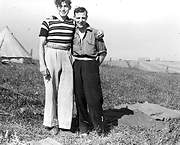 Donated by Mr. John Robinson
Donated by Mr. John RobinsonDated 1952
Apprentices Bruce Lindsay (left), and Jack from Wallsend at the Richardsons Westgarth summer camp at Whitby in 1952.
More detail » Richie's Summer Camp at Whitby
Richie's Summer Camp at Whitby
 Donated by Mr. John Robinson
Donated by Mr. John RobinsonDated 1952
Richardsons Westgarth organised a camp for apprentices each summer during the works annual holiday shutdown. This was an inexpensive holiday and open to apprentices from the four constituent companies. This is the 1952 camp at Whitby.
More detail » Richies Choir
Richies Choir
 Donated by Mr. & Mrs. Chappell
Donated by Mr. & Mrs. ChappellRichardsons Westgarth ("Richies"), choir displaying two of their trophies. J.William Brownlee is on the front row, fourth from the right.
More detail » Richies Control Panel
Richies Control Panel
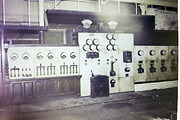 Created by Mr. John Brooker
Donated by Mr. John Brooker
Created by Mr. John Brooker
Donated by Mr. John BrookerRichardsons Westgarth Electric Supply Control Panel. Underneath this Control panel was a "secret" nightshift room incorporating 5 single beds, all made-up, and was still in situ in 1985.
More detail » Richies Whitby Camp - 1952
Richies Whitby Camp - 1952
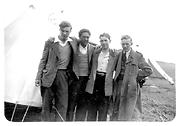 Donated by Mr. John Robinson
Donated by Mr. John RobinsonDated 1952
The Richardson Westgarth Apprentice Camp, Whitby, 1952. Left to right are: ?, Terry Harrison, Bruce Lindsay and John Robinson. Terry and Bruce worked in the Boiler Drawing Office and John in the Condensing and Feedwater Drawing Office. Terry, later, Sir Terrance, became the head of the Parsons/Rolls Royce company.
More detail » Sea Trial Data
Sea Trial Data
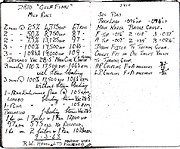 Created by Jim Wilson
Donated by Stuart James Wilson
Created by Jim Wilson
Donated by Stuart James WilsonDated 1961
An extract from Jim Wilson's personal workbook. This vessel, a Gulf tanker, was built by the Furness Shipbuilding Co. of Haverton Hill. Her main machinery was supplied by RW and |Jim was responsible for its erection and installation, also supervising performance during sea trials.
More detail » Sea Trials Programme Page 1
Sea Trials Programme Page 1
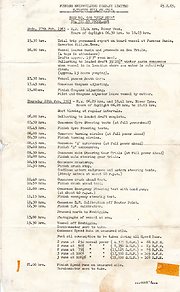 Created by Unknown
Donated by Stuart James Wilson
Created by Unknown
Donated by Stuart James WilsonDated 1963
Issued to Jim Wilson of RW, Hartlepool. "Richies" built the main machinery for this vessel and its erection and fitting was supervised by Jim Wilson.
More detail » Sea Trials Programme Page 2
Sea Trials Programme Page 2
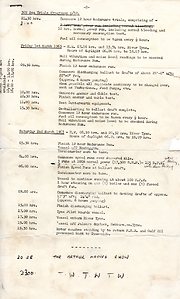 Created by Unknown
Donated by Stuart James Wilson
Created by Unknown
Donated by Stuart James WilsonDated 1963
Issued to Jim Wilson of RW. "Richies" built the main machinery for this vessel and its erection and fitting was supervised by Jim Wilson.
More detail » Secretaries in the 1950s
Secretaries in the 1950s
 Donated by Mr. John Robinson
Donated by Mr. John RobinsonSecretaries at Richardson Westgarth in the 1950s. Mary Smith (front row, third from the left), worked for Bernard Wyatt, the Techinical Director.
More detail » Shop Test Information
Shop Test Information
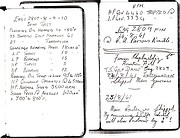 Created by Jim Wilson
Donated by Stuart James Wilson
Created by Jim Wilson
Donated by Stuart James WilsonDated 1961
Notes from Jim Wilson's personal workbooks for Engine No's 2807-8-9-10 whilst supervising the erection and installation of these marine steam-turbine sets aboard Gulf tankers by Furness Shipbuilding at Haverton Hill.
More detail » Staff from Richardsons Westgarth
Staff from Richardsons Westgarth
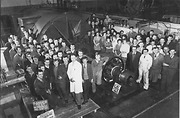 Donated by John Dee
Donated by John DeeStaff from Richardsons Westgarth, Hartlepool
More detail » Steam-Turbine Set
Steam-Turbine Set
 Created by Unknown
Donated by Stuart James Wilson
Created by Unknown
Donated by Stuart James WilsonDated 1959
This photograph shows Jim Wilson testing a steam-turbine set supplied by RW for a tanker built by the Furness Shipbuilding Co. of Haverton Hill. Jim also supervised the construction and installation of the main machinery for this vessel.
More detail » Taking a break
Taking a break
 Donated by Mr. Ken Stewart
Donated by Mr. Ken StewartRichardson Westgarth Apprentices Ken Stewart (left), and Tony Folland take a break on the dockside, sometime in the late 1940s.
More detail » Tanker Melika
Tanker Melika
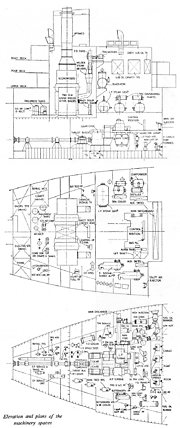 Created by Unknown
Donated by Stuart James Wilson
Created by Unknown
Donated by Stuart James WilsonDated 1953
Richardsons, Westgarth supplied the main machinery for this vessel. Erection and fitting of the steam turbines and gearing was supervised by Jim Wilson.
More detail » The Officials
The Officials
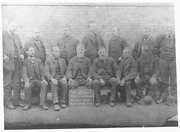 Donated by Douglas Ferriday
Donated by Douglas FerridayPart of the Hartlepool Library Service collection
Dated 1889
A group of officials at T. Richardson and Sons, Marine Engineering Works, in 1889. Later to become Richardsons Westgarth Engineering
More detail » Thomas Hindmarsh and Apprentices
Thomas Hindmarsh and Apprentices
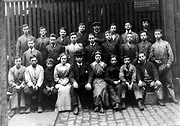 Donated by Mr. John Robinson
Donated by Mr. John RobinsonThomas Hindmarsh and a group of Apprentices outside the Richardsons Westgarth Pattern Shop in the 1920s or 1930s.
More detail » Three Draughtsmen
Three Draughtsmen
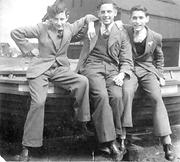 Donated by Mr. John Robinson
Donated by Mr. John RobinsonDated 1950
Three Richies draughtsmen. The man in the centre is Mr. J. H. Stonebank at the time living in Blackhall Colliery and now residing in Chelmsford, Essex, the names of the men either side are not known. The photograph is taken from the the boiler drawing office sitting on a boat outside the old lifeboat station at the Middleton Ferry c.1950.
More detail » Tommy Kell in Kuwait
Tommy Kell in Kuwait
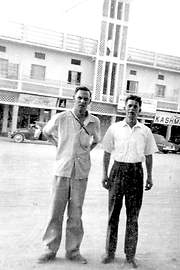 Donated by Mr. John Robinson
Donated by Mr. John RobinsonDated 1960
1960. Tommy Kell (left), was a gas turbine erector at this time working on the units exported to Kuwait. Tommy started as an office boy in 1940, completed his apprenticeship as a fitter, joined the Merchant Navy as an Engineering Officer, returned to RW as an erector on gas turbines (mostly overseas).
 Tough Times in the 1920s
Tough Times in the 1920s
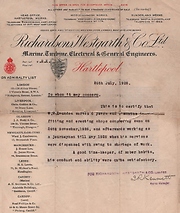 Donated by Mr. Stan Laundon
Donated by Mr. Stan LaundonDated 1928
The late 1920s saw the start of the Great Depression and jobs were very hard to find or keep, as this letter from "Richies" shows.
This letter was very kindly shared with us by Mr. Stan Laundon (http://stanlaundon.com), whose own website is well worth a visit.
More detail » Tough Times in the 1960s
Tough Times in the 1960s
 Donated by Mr. & Mrs. Chappell
Donated by Mr. & Mrs. ChappellDated 1963
Jobs were hard to find or keep in Hartlepool in the early 1960s as this letter from "Richies" shows.
More detail » Turning the Turbines (1)
Turning the Turbines (1)
 Created by Unknown
Donated by D R Album
Created by Unknown
Donated by D R AlbumPart of the D R collection
Dated 1953
One of five photographs taken by a Newcastle Photographer probably for the House Magazine, showing various turbines supplied to Anglesey and Thames side power stations in the mid-fifties , each with a turner posing for the camera but no other information!
More detail »
 Turning the Turbines (2)
Turning the Turbines (2)
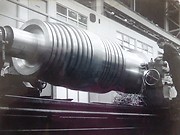 Created by Unknown Company , Newcastle Upon Tyne
Donated by D R
Created by Unknown Company , Newcastle Upon Tyne
Donated by D RPart of the D R Faimly Album collection
Dated 1953
One of five photographs taken by a Newcastle Photographer probably for the House Magazine, showing various turbines supplied to Anglesey and Thames side power stations in the mid-fifties , the back is marked "Mr Binks posed for the camera but no other information!
More detail »
 Turning the Turbines (3)
Turning the Turbines (3)
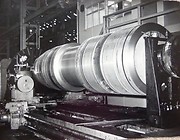 Created by Unknown
Donated by D R
Created by Unknown
Donated by D RPart of the D R Family Album collection
Dated 1953
One of five photographs taken by a Newcastle Photographer probably for the House Magazine, showing various turbines supplied to Anglesey and Thames side power stations in the mid-fifties , each with a turner posing for the camera but no other information!
More detail »
 Turning the Turbines (4)
Turning the Turbines (4)
 Created by Unknown
Donated by D R
Created by Unknown
Donated by D R Part of the D R Family Album collection
Dated 1953
One of five photographs taken by a Newcastle Photographer probably for the House Magazine, showing various turbines supplied to Anglesey and Thames side power stations in the mid-fifties , each with a turner posing for the camera but no other information!
More detail »
 Turning the Turbines (5)
Turning the Turbines (5)
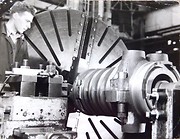 Created by Unknown
Donated by D R
Created by Unknown
Donated by D RPart of the D R Family Album collection
Dated 1953
One of five photographs taken by a Newcastle Photographer probably for the House Magazine, showing various turbines supplied to Anglesey and Thames side power stations in the mid-fifties , each with a turner posing for the camera but no other information!
More detail »
 Vertical Borer at Richardsons Westgarth (1)
Vertical Borer at Richardsons Westgarth (1)
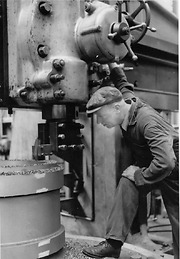 Donated by John Dee
Donated by John DeeVertical Boring machine at Richardsons Westgarth being operated by Johnny Dee. It took two days to set up machinery like this so, in the meantime, Johnny Dee used to cut the other men's hair.
He later went on to work in Reeds Corrugated Cases.
More detail » Vertical Borer at Richardsons Westgarth (2)
Vertical Borer at Richardsons Westgarth (2)
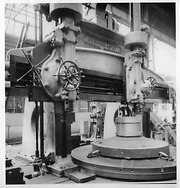 Donated by John Dee
Donated by John DeeVertical Borer (or Turner) at Richardsons Westgarth.
More detail » View from Richardsons & Westgarth
View from Richardsons & Westgarth
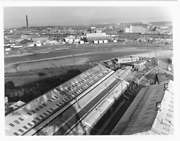 Donated by Douglas Ferriday
Donated by Douglas FerridayPart of the Hartlepool Library Service collection
Taken in 1964, this picture shows the slake and the water tower near Throston Bridge.
More detail » Villiers Street former Richardsons Club
Villiers Street former Richardsons Club
 Part of the Library collection
Part of the Library collectionPrior to demolition, the building in Villiers Street has been used as Harry's Taxis and also Richardson Westgarth Sports and Social Club.
HHT&N 253
More detail » Wedding of Harry Robinson to Mary Smith
Wedding of Harry Robinson to Mary Smith
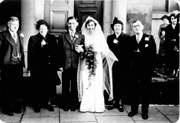 Donated by Mr. John Robinson
Donated by Mr. John RobinsonDated 1951
The 1951 wedding of Harry Robinson (Turbine Engineer), to Mary Smith, the Technical Director’s secretary. Mary’s father, John Smith also worked at Richardson Westgarth's in the toolshop.
More detail » Work Instructions
Work Instructions
 Created by Jim Wilson
Donated by Stuart James Wilson
Created by Jim Wilson
Donated by Stuart James WilsonDated 1959
Concerning the alognment of steam turbines and gearing. Prepared by Jim Wilson.
More detail »





